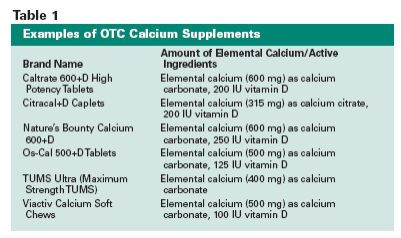Publication
Article
Pharmacy Times
Calcium
Author(s):
Calcium
Calcium is the most abundant mineral found in the human body. Approximately 99% of the body?s calcium is stored in the bones and teeth, and the other 1% is in the extracellular fluid, intracellular structures, and cell membranes.1,2 Calcium has several significant roles that include the activation of many enzymes and the synthesis of acetylcholine. Calcium also is responsible for increasing cell membrane permeability, facilitating the absorption of vitamin B12, and regulating muscle contraction and relaxation, as well as having a role in blood coagulation and nerve conduction. In addition, calcium is very important in the regulation of the heartbeat.1,2
Calcium supplements are widely used to reduce or prevent the incidence of osteoporosis. In 2002, calcium supplements were the number-1-selling mineral supplement and the third top-selling supplement overall in the United States.1
According to the National Osteoporosis Foundation (NOF), an estimated 10 million individuals have osteoporosis, and ~34 million more have an increased risk for developing osteoporosis.3 Furthermore, because women are more prone to osteoporosis, they account for 8 million of the 10 million individuals who have osteoporosis.3 It is estimated that women may lose as much as 20% of their bone mass in the first 5 to 7 years following menopause, thereby increasing their risk for developing osteoporosis.3 The risk factors associated with an increased incidence of osteoporosis may be classified as nonmodifiable or modifiable. By knowing possible risk factors, women can attempt to incorporate lifestyle changes so as to alter modifiable risks and decrease the possibility of developing osteoporosis.
Calcium Supplements
Although calcium is best obtained through dietary sources, many individuals do not obtain enough calcium through dietary means alone. The National Academy of Sciences and the NOF recommend daily calcium intakes of 1000 to 1200 mg/day for adult men and women.4 The average daily intake of dietary calcium among Americans is 800 mg. Therefore, a vast majority of individuals may rely on the use of calcium supplements.5 The FDA has approved calcium supplements for the treatment and prevention of calcium deficiency. Deficiencies in calcium may result in an increased risk of rickets, osteomalacia, or osteoporosis.2 In addition, calcium supplements are approved for treating acid indigestion, as well as hyperphosphatemia that is associated with end-stage renal disease.2 Studies have shown that the use of calcium supplements also may be helpful in alleviating or possibly preventing pre-menstrual syndrome (PMS). In fact, the American College of Obstetrics and Gynecology recommends routine use of calcium supplements in girls and women who experience PMS.2
Patient Counseling
Currently, a variety of calcium supplements are on the market (Table 1). Calcium carbonate and calcium citrate are the 2 most common forms of calcium. Calcium carbonate supplements contain 40% elemental calcium, whereas calcium citrate supplements contain 21% elemental calcium. Because calcium carbonate products are insoluble salts, patients should be counseled to take supplements containing calcium carbonate with food to augment absorption.2 Calcium citrate products can be taken without regard to food. Other forms of calcium include calcium lactate, calcium gluconate, and calcium phosphate.2 Patients should be reminded to select only supplements whose labels state ?purified? or have the United States Pharmacopeia (USP) symbol.1

Through assessment of patient medication profiles, pharmacists can identify females at a greater risk for bone loss or osteoporosis due to the use of certain medications.
Pharmacists are in a crucial position to identify possible drug interactions that may occur when certain drugs are used in conjunction with calcium supplements and to make clinical recommendations accordingly.
Because calcium can interfere with the absorption of bisphosphonates, it is important for pharmacists to remind patients to wait at least 30 minutes before taking calcium supplements if they also are taking bisphosphonates?such as alendronate, alendronate/ cholecalciferol or risedronate?and at least 60 minutes if taking ibandronate.6-8 Examples of other medications that should be administered in separate dosing intervals (at least 2 hours apart) when used in conjunction with calcium supplements include aluminum-containing antacids, tetracyclines, and fluoro-quinolones.
See the Patient Counseling article entitled Osteoporosis: A Silent and Insidious Disorder on page 110.
Total calcium intake, including dietary as well as calcium in multivitamin supplements and calcium supplements, should not exceed 2 g per day, because higher doses can be harmful and can result in elevated calcium levels in the urine and renal stones.2 In addition, because calcium absorption is dependent on an adequate level of vitamin D and many calcium supplements are formulated with vitamin D, patients currently taking multi-vitamins with 100% of the recommended daily intake of vitamin D should be advised to avoid these formulations of calcium supplements due to possible toxicity. In these cases, patients should use the supplements containing only calcium.
Pharmacists also should remind patients that calcium absorption is improved by dividing the doses into 500 mg 2 to 3 times a day. They should stress the importance of maintaining sufficient hydration, intake of dietary fiber, and routine exercise, because the use of calcium supplements may cause constipation for some individuals. In addition, some individuals may experience bloating and flatulence.2,5 Patients should be encouraged to discuss prevention and treatment of osteoporosis with their primary health care providers. Pharmacists should take every possible opportunity to educate patients and to increase awareness about osteoporosis and to empower women with the information necessary to prevent or reduce the incidence of this condition.
Please visit www.pharmacytimes.com/osteoporosis for a table on risk factors and a table on recommended adequate intake of calcium.
References
1. Dietary Supplement Fact Sheet Calcium. National Institutes of Health Office of National Diet Supplements Web site. Available at: http://ods.od.nih.gov/factsheets/calcium.asp.
2. Huckleberry Y, Rollins C. Essential and conditionally essential nutrients. In: Berardi RR, Kroon LA, McDermott JH, et al, eds. Handbook of Nonprescription Drugs. 15th ed. Washington, DC: American Pharmacists Association; 2006:459-460.
3. Fast Facts. National Osteoporosis Foundation Web site. Available at: www.nof.org/osteoporosis/diseasefacts.htm.
4. Osteoporosis. Medline Plus Web site. Available at: www.nlm.nih.gov/medlineplus/osteoporosis.html.
5. Calcium. PDR Health Web site. Available at: www.pdrhealth.com/drug_info/nmdrugprofiles/nutsupdrugs/cal_0052.shtml.
6. Fosamax package insert. Available at: www.fosamax.com.
7. Actonel package insert. Available at: www.actonel.com.
8. Boniva package insert. Available at: www.boniva.com.
9. Prevention: Calcium Supplements. National Osteoporosis Foundation Web site. Available at: www.nof.org/prevention/calcium_supplements.htm.

Newsletter
Stay informed on drug updates, treatment guidelines, and pharmacy practice trends—subscribe to Pharmacy Times for weekly clinical insights.






